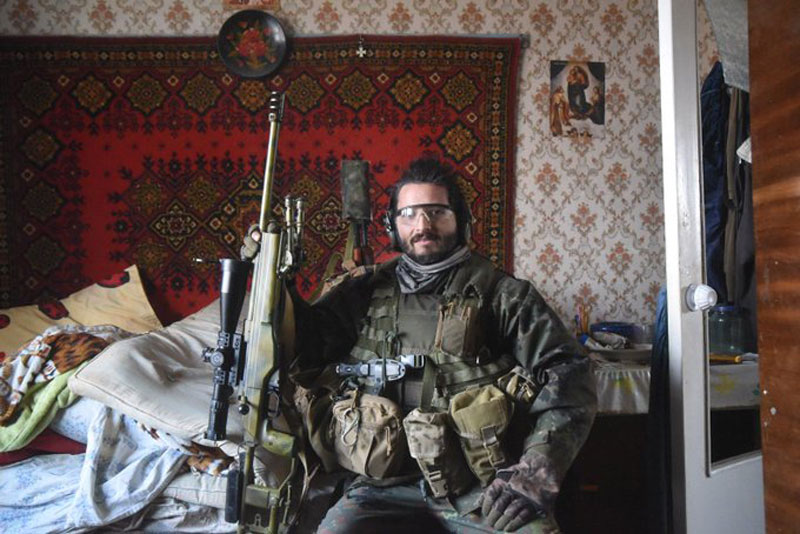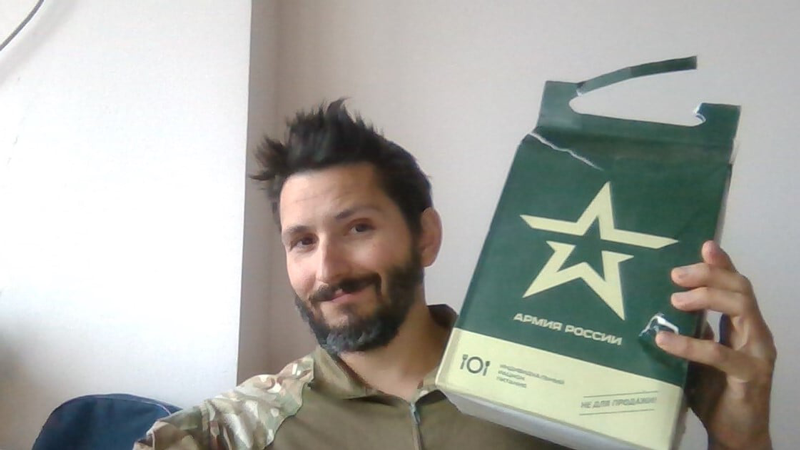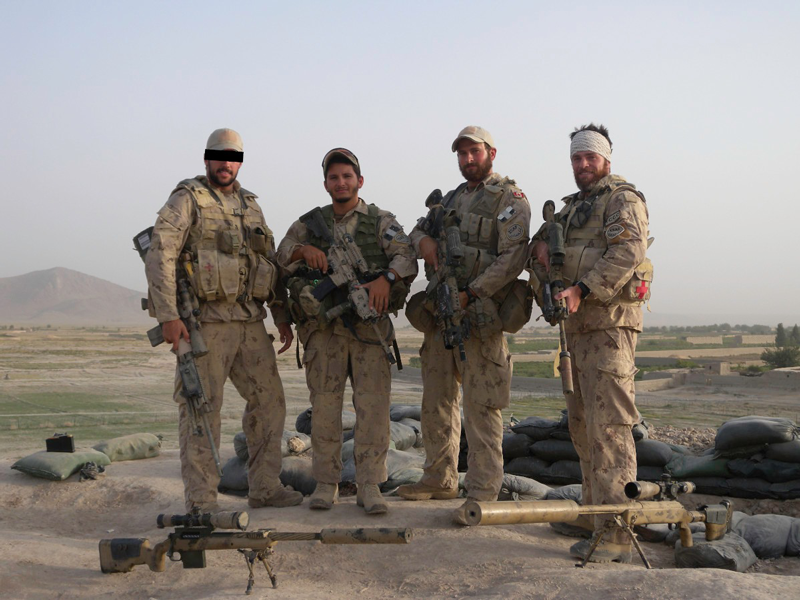
Wali in full kit. The Canadian sniper is currently in Ukraine fighting alongside national army troops.[ La Torche et l’Épée/The Torch and Sword]
Both feared and reviled by their enemies, they perform their deadly work from the shadows—and they prefer to keep it there. Some are haunted by their victims: “I see their faces,” a Ukrainian sniper named Sasha recently told The Economist.
Wali, a veteran of multiple wars, is not one of those snipers. The Montreal-native doesn’t mind talking about his vocation and he doesn’t really seem to care who hears it.
He served one of two Afghanistan combat tours with a four-man sniper team from the Royal 22nd Regiment, primarily as a spotter. In the relatively limited time he was the actual trigger man on their .338 and .50 calibre rifles, he killed two Taliban fighters.
Since retiring in 2015 after 12 years in the Canadian military, he’s done two stints as a volunteer fighting ISIS in Iraq. Now 40, with a little grey sprouting from his chin and complaining of a sore back, he’s in Ukraine fighting Russians.
He records his exploits in a blog, on video and in pictures—lots of pictures. He has a website, Facebook and Instagram accounts and a Wikipedia profile. He’s all over Twitter and YouTube, is featured in two documentaries and has written two books. His name has appeared in Newsweek, Le Figaro, Vanity Fair France, virtually all of London’s former Fleet Street tabloids and The Christian Science Monitor.
Canadians hold three of history’s five longest recorded sniper kills.
Wali is his nom de guerre—Arabic for “protector” or “guardian.” And, contrary to reports, he is not a “world-renowned” sniper, nor “the world’s deadliest sniper,” not even “one of the world’s deadliest snipers.” In fact, he is not even particularly “feared,” any more than any trained marksman ensconced in a hide with a .338 and a scope is feared by an enemy with a functioning brain and a beating heart.
He was, however, trained and embedded in what is indisputably the finest sniper program in the world. Canadians hold three of history’s five longest recorded sniper kills, including the current record of 3,540 metres, set by an anonymous Canadian special forces’ shooter in Iraq in May 2017.
“I feel a bit, like—‘shy,’ I would say—when people say ‘he’s such a good sniper,’” Wali told Legion Magazine in an hour-long video interview from Ukraine. “I’m just a ‘good’ soldier among other good soldiers—that’s how I see things.”

Wali shows off some captured Russian rations, left behind by retreating enemy near Kyiv.[La Torche et l’Épée/The Torch and Sword]
“Being an elite shooter is like a psychologist’s job.”
Now he’s part of a small Ukrainian army unit—his plaudits, he says, a morale-booster among his Ukrainian comrades-in-arms, who get pictures taken with him. His notoriety recently escalated when it was rumoured he’d been killed in action, only to turn up alive and well for another round of interviews with world media.
“The information war,” he says, “is critical.” Russia’s, he adds, is blunt and transparent. “Their propaganda is so grotesque…and so rude. It is not subtle.”
He has a camera but no spotter. He didn’t even have a range-finding scope at the time of this interview and thus, at distances of 700 metres or more, he was eyeballing ranges and associated trajectories.
Wali, father of a one-year-old son, appears younger than his years, especially given all he has seen and endured. With an unkempt mop of dark hair, the mischievous eyes of a troublemaker and a warm smile, he is lighthearted, engaging and matter-of-fact.
There is no air of bravado or boastfulness about him, though in a recent post he shared a picture of himself holding a bag of rations left behind by a retreating enemy, thanking them for the “gift.”
At the time he was interviewed, he had been in Ukraine about a month, had gone on multiple operations and, out of an abundance of caution, hadn’t shot anyone.
“Other snipers [caused] a few casualties among the Russians,” he said. “I could have shot in recent weeks but, the situation I was in, I decided not to shoot because it looked like they may have been refugees.”
When he first arrived in-country, he thought picking out the enemy would be easy because, unlike in Afghanistan, Iraq and Syria, where insurgents wore no distinctive clothing, he expected combatants in Ukraine to be uniformed.
It turned out not to be so straightforward. More than three million Ukrainians have left the country but there are still enough refugees about that he says squeezing the trigger requires extra measures of certainty.
“The refugees are still afraid and they kind of move in tactical fashion,” he said. “At some points, I saw people in no man’s land and I had the right to shoot but, you know, they are still human and I don’t want to shoot innocent people. It’s my decision. So, for now I have zero kills as a sniper in Ukraine.”
In a recent blog post, he described seeing a man moving tactical-style between buildings. He was carrying something.
“Being an elite shooter is like a psychologist’s job,” he wrote in translated English. “We need to understand our environment, our land, our prey. Moving my gun around. The buildings are destroyed. Several are still clearing smoke, following the fires caused by Russian artillery.”
As he scans his weapon again, he detects a small fire inside a building and realizes someone is in there trying to stay warm. The man outside moves again. Wali is preparing to shoot him. Then he realizes the bundle under his arm is firewood.
“It’s not a Russian, it’s a Ukrainian! This man [is collecting] the debris of houses between us and the enemy! He should not be there. I was…two fingers away from shooting. One finger, to be more precise, and less than 2 pounds of pressure.”
“I’m not here to kill, but to protect,” he writes. “A warrior who [only seeks] to kill is nothing but a murderer. A warrior must be [honourable] first and foremost.”
Nevertheless, his unit and their supporting artillery have exacted a toll. Overall, Russian forces have lost multitudes of equipment and around 20,000 casualties in a 48-day-old invasion that, by all accounts, was expected to last less than a week.

Wali with comrades-in-arms from the Van Doos in Afghanistan.[La Torche et l’Épée/The Torch and Sword]
“I cannot figure out how they expend so much ammunition.”
Russian morale, he claims, is low. Large numbers of Russian troops have simply walked away from the fight. At least six of 20 Russian generals deployed to Ukraine are said to have been killed, along with more than a dozen colonels.
It’s unusual for such high-ranking officers to be in the line of fire, but they are believed to have taken a hands-on approach because the ranks of the 150,000-plus invasion force are made up largely of under-trained and ill-equipped conscripts.
“In front of our position, they abandoned their dead,” said Wali. Locals in occupied areas have been telling his unit by cellphone message that Russian officers “get drunk a lot and they steal and plunder.”
“They take all the fancy stuff—televisions, jewelry. Everything they put in trucks and send back to Russia. We have that information from many sources. I think it’s a sign of very bad leadership. They shoot dogs.”
Russian co-ordination and supply have been abysmal. And Wali says their modus operandi is quantity, not quality, of fire. “They just shoot so much that, with time, they get you,” he said. “That’s how they work.”
By contrast, he adds, a NATO-style army tends to act on observation and intelligence, detecting and destroying with more efficiency and precision.
“The Russians are just going to blow everything and eventually they’ll kill someone,” he said. “They’re having a lot of casualties and they’re expending so much ammunition. When you go on the front line, it’s crazy. Some days, they just shoot and shoot and shoot and shoot.
“I cannot figure out how they expend so much ammunition.”
Russian forces are known to be short on precision-guided munitions, and those they have brought have been plagued by duds. Experts blame damage to their electronics caused by poor storage and the rough ride by rail and road to the front.
“I heard a lot of duds,” said Wali, making the sound of a hiss and a thump. “Nothing. More than usual, I think. Maybe they’re using old ammunition and they don’t have a lot of ammunition left—maybe. But I don’t think they can sustain such an intense fight for years because it’s going to drain their economy.”
“I had no choice. It’s like, I can do something so I must do something.”
There are some 20,000 foreign fighters in Ukraine. Most have joined the International Legion of Territorial Defense of Ukraine. With the world’s third-largest population of people of Ukrainian origin, about 1.4 million, Canada has had so many volunteer fighters that they formed their own brigade.
Wali, however, has been the subject of much discussion among veterans, who appear split on what he’s doing. The doubters question his motives; others say he’s done nothing to tarnish the reputation of the Canadian military. Some applaud the fact he’s doing more than watching the action on video and TV from a couch.
To those who ask why, he replies: “Why not?”
He got a call from a friend with family in Ukraine the day after the Feb. 24 invasion. There wasn’t time to think or even properly stock up on supplies, he said.
“I did not say no; I said yes. I had no choice. It’s like, I can do something so I must do something.”
That was a Friday. Unlike most foreign fighters, he signed no contract.
“I knew how critical the situation was. It’s a conventional war; the Russians were pushing very quickly. It’s not like I could wait two weeks or a month. I had to go quickly. Speed was more critical than perfect execution.
“They needed manpower.”
—
For more on Wali, visit his website.
Advertisement





















